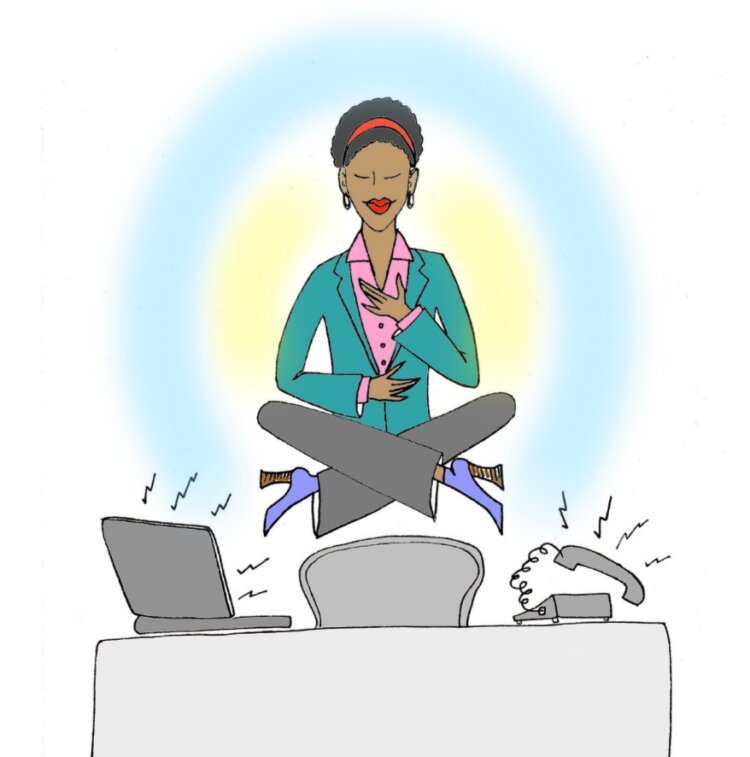
One of the icky feelings that comes with stress is shortness of breath. This is actually by design; when we’re in danger, our bodies prepare to either do battle or get the heck out of Dodge with a series of physical responses, including the breath coming in short, energetic bursts. It’s brilliant engineering, except for one tiny flaw: When this happens to us now, we’re usually not in situations that require us to fight or flee. We’re usually at work, having a fight with a friend, or in some non-urgent situation where we’d really, really love to calm down quick.
But don’t stress even more about that. There’s a great hack built into your beautiful body: While breathing is technically involuntary, we can alter our breathing patterns. And while the perception of danger in the mind can trigger the body’s stress response, making conscious changes to your breathing can help both body and mind calm down.
Magic! How is it done? Ancient Yogis studied breathing intensively, and even though their practices are thousands of years old, they work like a charm. With any breathing practice, be gentle, inhaling and exhaling in a way that feels comfortable. If you feel any dizziness or discomfort, stop the practice and return to your normal breathing pattern. ‘Kay?
Deergha Swasam, Three-Part Breath
This is the mother of all Yoga breathing practices, and it’s one of the most user-friendly because of its ease and stealth: You can do this during a tense meeting at work and be the calmest person in the room.
Start by sitting up tall in your chair, feeling your spine lengthened. If you like, you can place one hand on your chest and the other on your belly to feel the wave of the breath. Then inhale from the belly, bring the breath to your lower ribs, and all the way to your upper chest. Exhale from your upper chest, relax your lower ribs, and gently pull in your belly. Inhale using your belly muscles; expand lower ribs; breathe to the upper chest. Exhale from upper chest, lower ribs, and abdomen. Repeat for a few rounds, then return to your normal breathing pattern.
Alternate-Nostril Breath
Known in Yoga as Nadi Suddhi (NAH-dee SHOO-dee), Alternate Nostril Breathing is a little tricky, but that’s part of what makes it so calming. Focusing on the rhythm of the hand-breath coordination gives your mind something to focus on instead of what’s worrying you. Read through these instructions first, or watch this demonstration on my IGTV channel or Facebook page. Then try it yourself.
To begin, sit up tall, but not stiff. Next, the Yoga mudra (hand position) for this practice is to fold in your index and middle fingers and extend your thumb and last two fingers. If that feels strange or too complicated, you can extend your thumb and index finger as though you were pointing at something, and fold in the rest. Whichever finger configuration you use, bring your hand close to your nose.
Exhale comfortably, then gently press your right nostril closed and inhale through your left nostril.
Move your hand to gently press your left nostril closed and open your right nostril. Exhale through the right nostril.
Inhale through the right nostril, then close and exhale through left.
Inhale left, close, exhale through right; inhale right, close, exhale through left. So the pattern is: inhale left, close, exhale right; inhale right, close, exhale left.
Do this for a few rounds, then let your breathing return to normal.
Book on the Belly Breath
Part of my Yoga teacher training was learning how to teach Yoga to children, including breathing techniques to help them calm down. We were each given a small stuffed animal and instructed to lie down and place the toy on our bellies. (I got a sweet pink octopus.) “Now make your stuffed animal rise and fall with your belly,” our trainer said. The breaths were not to be too deep; the goal was to switch from breathing in the upper chest to breathing in the belly.
As infants, we breathed using the belly muscles. As adults, that breath moves from the belly to the chest, and in times of stress, to the upper chest. That upper chest breathing is part of the fight-or-flight response, and we may not even notice when we’re stressed that our breathing has become very shallow. Belly breathing is more relaxed, and switching to belly breath is something that can be felt and seen when you place something on your belly and make it rise and fall. If you have a stuffed animal handy, use that—it’s a lot more fun. If not, a book (not too heavy, please) will do fine. Remember that you only have to make the book or pink octopus rise and fall an inch or so.
Next time you’re feeling stress, you’ll have a secret weapon for calm: your very own breathing. Stay peaceful, divine lights.


Grok Nation Comment Policy
We welcome thoughtful, grokky comments—keep your negativity and spam to yourself. Please read our Comment Policy before commenting.